
Digital transformation of a chocolate museum
fields
- case study
- ux design
- ux strategy
Problem statement
The outdated digital infrastructure and the lack of seamless integration between online and on-site experiences, challenges the Chocolate Museum to enhance visitor engagement and attract new guests.
The current digital presence is fragmented with a lot of scattered information across different platforms, making it difficult for visitors to engage with the museum’s content and services efficiently.
Action plan
Develop a cohesive digital strategy that unifies these scattered points and eventually transforms how visitors interact with the museum, by making their journey smoother and more rewarding.
As short-term tactics, we will redesign the museum’s website to provide a user-friendly interface that offers visitors all necessary information. We will also integrate mobile apps that align with visitors’ expectations, ensuring they can easily engage with the museum from the comfort of their homes or during their visits.
As long-term strategies, we will establish business model frameworks that will help the museum achieve greater sustainability and continue to offer enriching experiences in the future.
Exploring visitor needs to shape a better experience
In order to get a better look on the problem, first we have to evaluate whether the initial briefing meets the real needs of visitors. What are their motivations, expectations and frustrations?
From the fact finding workshop we clustered and prioritised three core perspectives of our visitors needs:
Kids’ experience
Information accessibility
Visit
This clustering helped us define the main needs and challenges to be solved. We used the challenge mapping method for this process. The findings of this mapping will be used as the starting point of the solutions’ brainstorming.
Perspective 1: Kids’ experience
Challenge 1: How can we increase the interactivity between parents and kids?
Brainstorming challenge 1: How can we promote interactive learning for children?
Perspective 2: Information accessibility
Challenge 2: How can we provide more information online?
Brainstorming challenge 2: How can we create relatable online content?
Perspective 3: Visit
Challenge 3: How can we create more stimulating experiences for visitors?
Brainstorming challenge 3: How can we motivate the visitors?

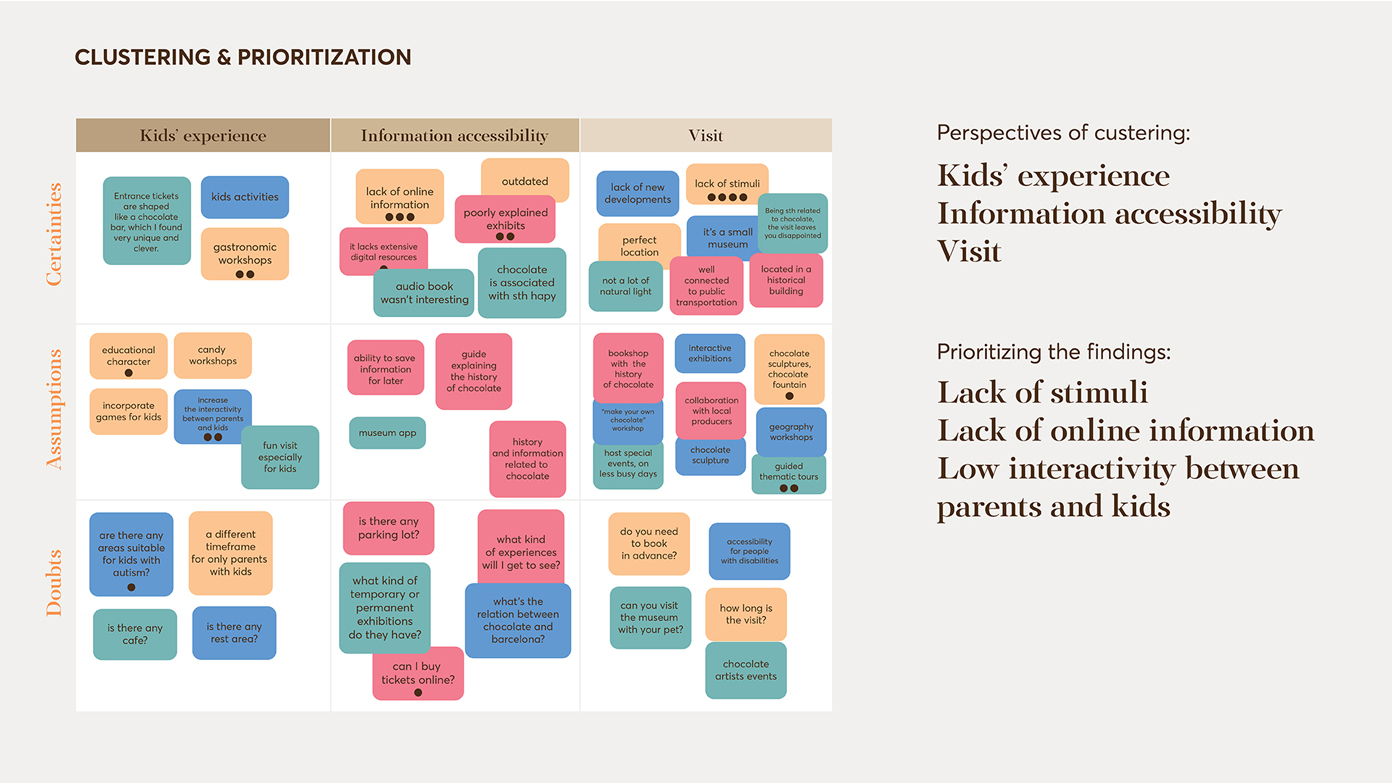
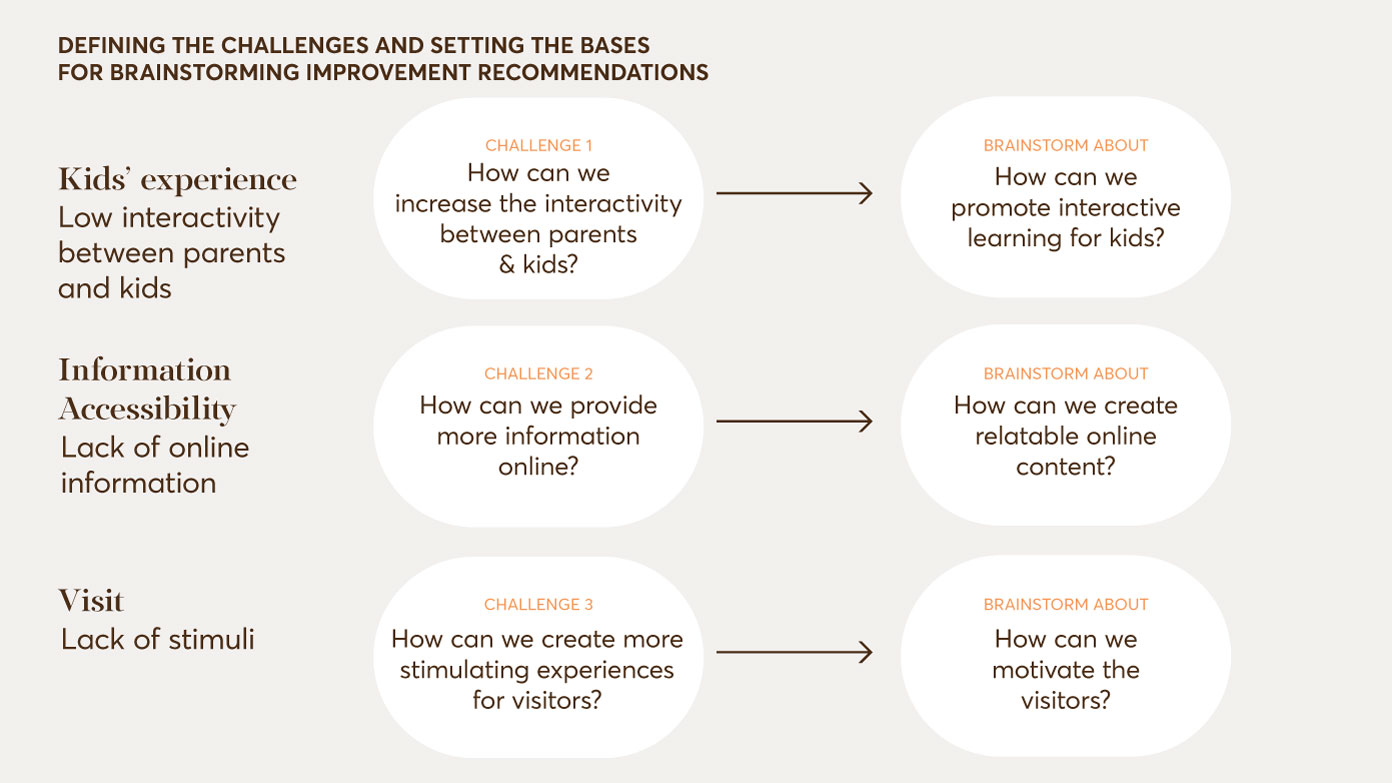
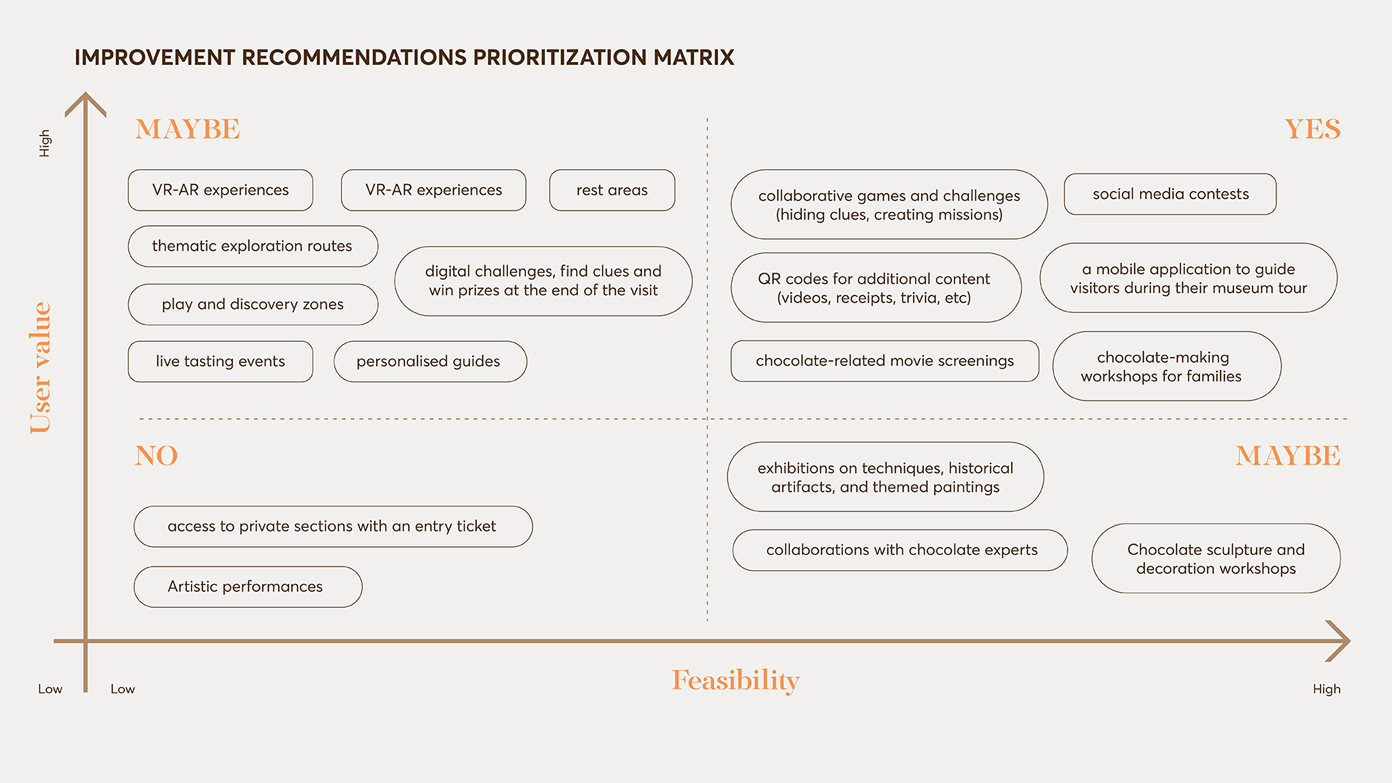
Findings
The results of the brainstorming and challenge mapping workshops have given a lot of improvement recommendations. These recommendations have been categorized and prioritized based on the feasibility of the project and user value. The following recommendations have been identified as the most critical and relevant.
Workshops for children and parents Offer interactive opportunities that engage multiple senses, stimulate children’s curiosity and creativity, and strengthen the parent-child relationship.
Tasting and pairing events In collaboration with local establishments, experts, and chocolate artisans.
AR/VR for an immersive educational experience Virtual exploration of cocoa plantations, chocolate factories, historical sites, etc.
App providing personalized information About museum news, events, products, workshops, etc.
Evaluating the existing digital services of the museum
The museum offers the following digital services:
Online shop
Online tickets purchase
Online reservation for activities
As already mentioned, the information of the current website is scattered, making the user’s journey unpleasant and confusing.
We conducted interviews with 4 participants to better understand their needs and their perceptions of the digital services that the Chocolate Museum offers.
From the results of the user interviews we have created a Persona, Gema, who represents one of the museum’s potential clients. Through the Customer Journey As-Is we get to gather insights about the interaction frictions, user’s painpoints and improvement opportunities.


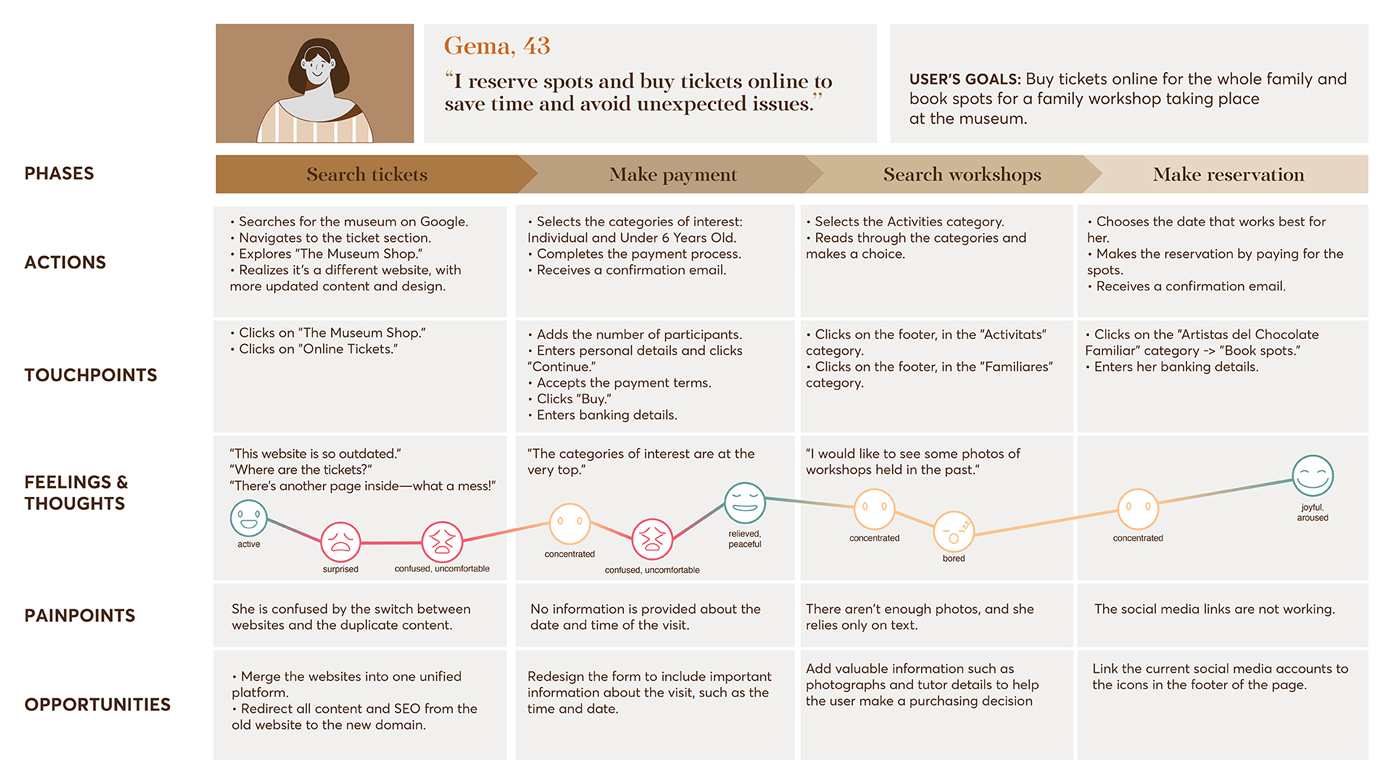
Optimizing the Chocolate Museum experience
Through the Customer Journey As-Is, we have identified some opportunities that serve as points for improvement. The purchase and booking process lack valuable information such as date and time of visit. The system doesn’t provide details about the activities either, making it difficult for the user to decide what to reserve. Here are the main points of improvement, based on two pillars: Streamlined purchase process and visitor engagement.
How can we streamline the purchase and booking process?
- Redesign the online ticket sales form with an integrated calendar (visit time, date)
- Add relevant information (photos, facilitators bios) in the activities section to help the user make a decision efficiently.
How can we retain users and engage them with the website’s content?
- Unify the two pages into one (online shop’s website and museum’s website).
- Redirect the content and SEO from the old page to the new one to increase visibility and traffic.
- Link updated social media accounts to create a cohesive brand experience and build visitor loyalty. Add SSL certificate for secure payments, and for creating trust to the users.

Mapping the sweet spot: Crafting a value proposition that resonates
Objective: Check, using the Value Proposition Canvas, whether the business creates value for its customers.
After incorporating the improvement recommendations gathered throughout the research, we see that the value proposition aligns with the customer profile as most of the customer’s satisfactions and frustrations are addressed by the value proposition.
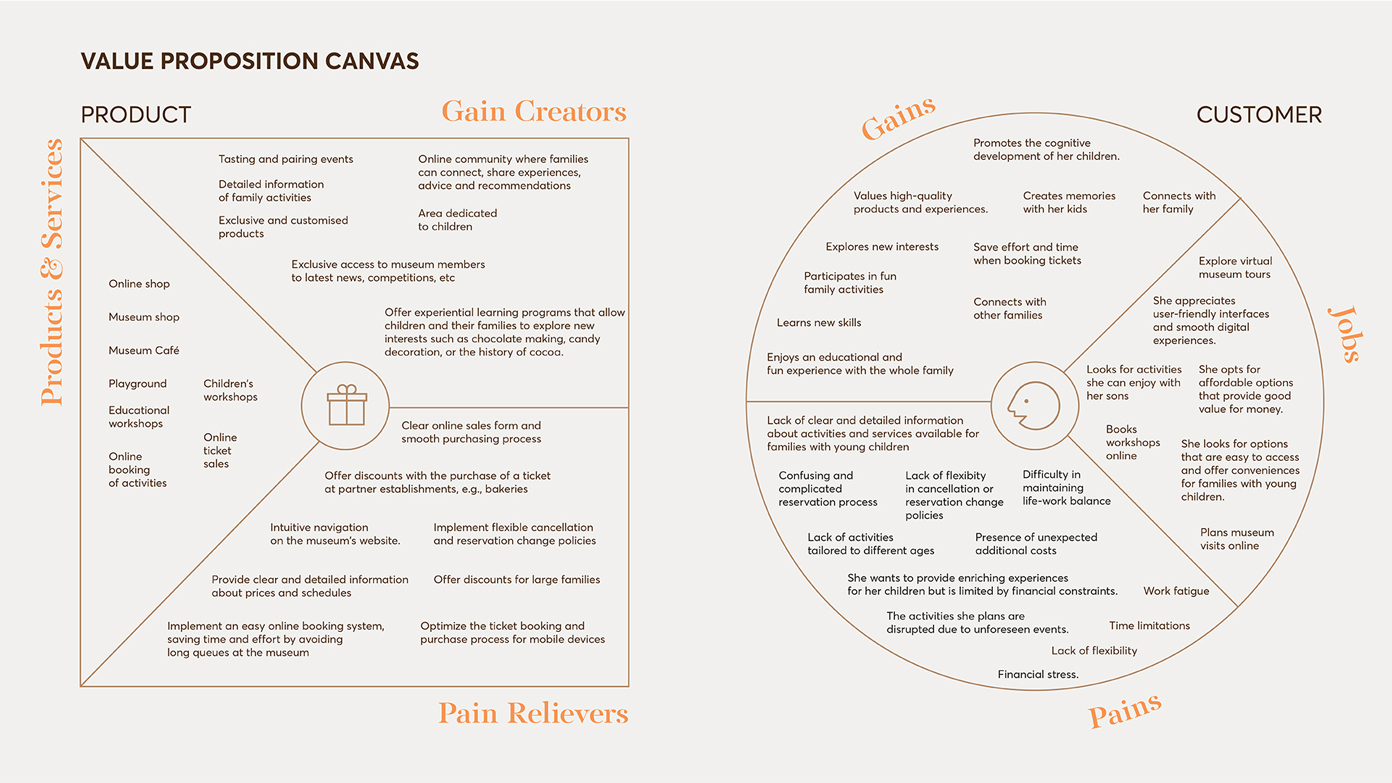
Defining a unique path: Strategic Differentiation for the Chocolate Museum
Objective: Analyze and assess which of Michael Porter’s three generic strategies best fits the needs of the business.
The business landscape is constantly evolving, making a clear strategy essential for success. Porter’s Four Competitive Strategies and Five Forces Analysis offer a strong blueprint to navigate this complexity and stay ahead in the market.
Due to the nature of the industry in which the business operates, it is advisable to opt for unique services and products that add value to a specific market segment that values quality, exclusivity, and authenticity.
By applying a differentiation focus strategy, the chocolate museum can position itself in the market as a unique and exciting destination offering exclusive and memorable chocolate-related experiences. This approach appeals to a specific market segment that values quality, exclusivity, and authenticity, such as chocolate enthusiasts and families seeking educational and entertaining experiences for their children.
How is differentiation focus strategy applied to the chocolate museum?
• Focus on quality and exclusivity: Prioritize offering high-quality products and services that provide additional value to visitors, making them feel they are experiencing something special and unique. Examples include: Collaborations with renowned local chocolatiers, edible art exhibitions, or chocolate tastings.
• Personalization of the experience: Provide customization options that allow visitors to shape their museum experience according to their individual interests and preferences. Examples include: Private guided tours or customised educational programs that offer an exclusive experience, bespoke merchandise exclusively designed for the museum.
• Targeted marketing: Develop marketing campaigns specifically aimed at the identified segments (chocolate enthusiasts, families), emphasizing the unique and distinctive aspects of the museum that are most relevant to these audiences. Examples include: Advertisements in gourmet magazines, collaborations with social media influencers, or special events focused on these specific market segments.
Crafting tomorrow: Choosing business models for the chocolate museum
Objective: Specify, through the Business Model Canvas, how the business will create value.
Business model navigator
• Experience Selling: The museum can adopt a business model focused on Experience Selling by offering unique and immersive experiences that go beyond traditional museum visits, creating memorable moments for visitors. In this way, the chocolate museum can increase visitor engagement and satisfaction.
• Open Business Model: By adopting an Open Business Model, the chocolate museum can collaborate with external partners, such as artists, researchers, educators, and technology companies, to co-create content, develop exhibitions, and innovate new programs. This approach allows the museum to leverage new ideas, perspectives, and resources, leading to greater innovation and relevance.
• Customer Loyalty: The museum can cultivate customer loyalty by offering membership programs and personalized experiences for its visitors (for example exclusive access to special exhibitions, members-only events, and discounts on products, merchandise and services). By building strong relationships with its audience, the museum can foster loyalty, encourage repeat visits, and achieve sustainable support and growth.
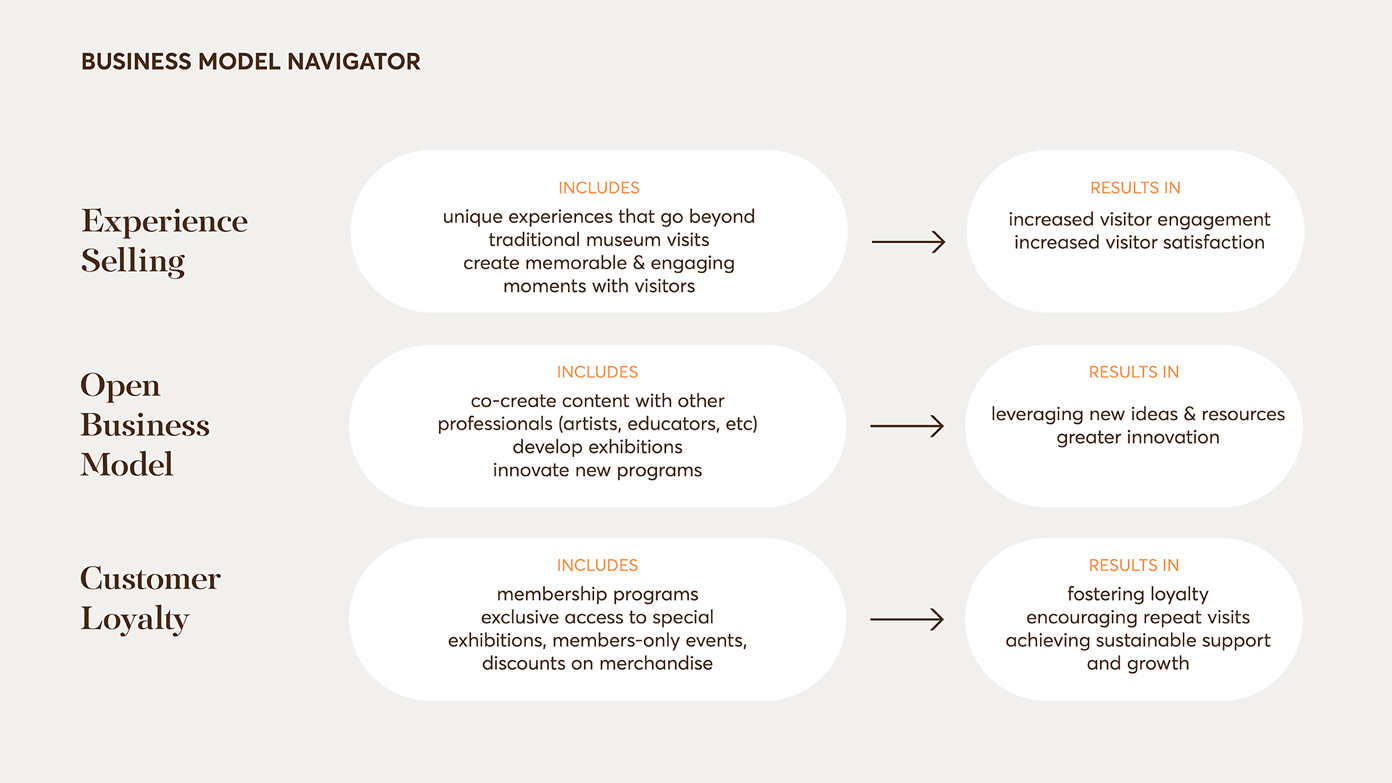
Design Futures: Moving across time, beyond market constraints, toward transformative possibilities that reimagine society, technology, and the human experience.
Sparking questions about future worlds that reflect the issues of today
By looking at different futures and designing solutions to prepare for them, we can make better decisions for the Chocolate Museum and set priorities for future strategies. We need to think about what the Chocolate Museum will be like in 30 years.
How will information be collected and displayed in the future?
First, we conducted a competitive analysis to discover emerging tendencies in the field, using three key criteria: Visitor’s experience, Exhibition & Content, Marketing & Advertising. Then, we conducted interviews with Millennials and Gen Z to gather qualitative data about their needs and expectations regarding the future of the museum industry (culture and tourism). These generations are essential because they will be the main visitors and decision-makers in the future.
Probable futures
These are futures we believe are “likely” to occur, usually based on current trends, which are often quantitative. Since they are based on historical data and pattern analysis, they have a high probability of occurring.
• Increase in digitalization The current trend promotes a rise in the use of digital technologies in museums. The most probable future is that museums will continue using technologies like virtual reality, augmented reality, and online educational platforms to enhance the visitor experience and bring additional value to their services.
• Focus on sustainability Right now, the current trend is the demand for sustainable practices across all industries. The most probable future is that the museum will adopt sustainable practices in all its operations and educate visitors about the ethical and sustainable production of chocolate.
• Personalization of the visitor experience The growing use of data to personalize user experiences is one of the most important trends today. In a probable future, the museum will offer more personalized experiences through apps and guides based on artificial intelligence, adapting tours and activities to the preferences of each visitor.
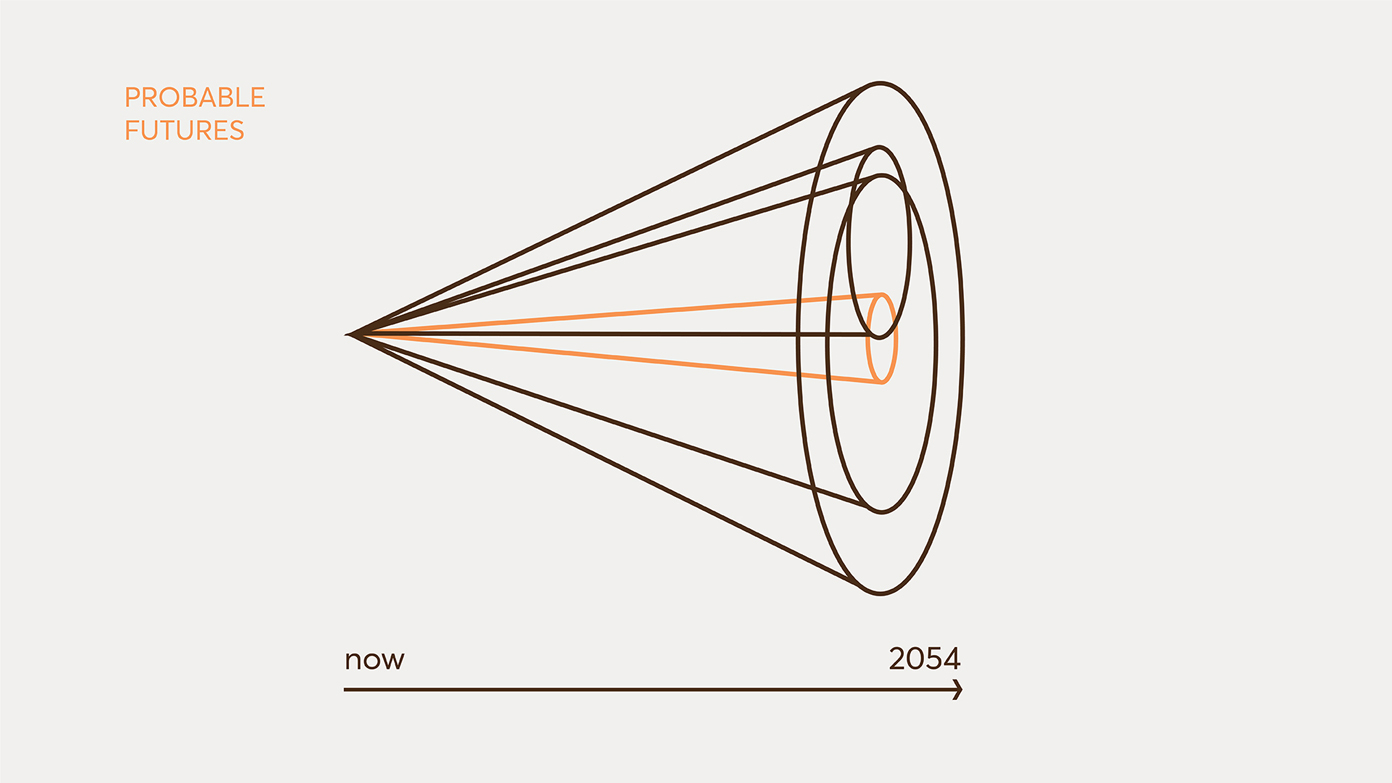
Plausible futures
These are futures we think “could” happen, based on our current understanding of how the world works (physical laws, social processes, etc.). These futures are less certain than probable futures but could still occur under certain conditions or significant changes in current trends.
• Dramatic changes in tourism Significant shifts in tourism patterns due to factors like pandemics, climate change, or new international regulations could impact museums, requiring them to adapt their visitor attraction strategies by focusing more on local tourism or virtual experiences.
• Innovation in education Revolutions in educational methods that transform how people learn and consume information, such as fully immersive education, could lead the museum to integrate these new methodologies into its educational programs, offering more interactive and personalized learning experiences.
• Revolution in chocolate production Potential drastic technological advancements in chocolate production, such as the creation of synthetic chocolate without cocoa, could bring radical changes to the supply chain and the museum’s exhibits.

Possible futures
These are futures that “could” occur, based on future knowledge we do not yet possess but may acquire someday. This category is broad and speculative, and exploring it allows us to think beyond conventional limits and prepare for any eventuality.
• Collapse of tourism A global event (such as a natural disaster) causes a drastic decline in tourism. As a result, the museum must reinvent itself to attract a local and virtual audience, developing new revenue streams and ways to interact with visitors.
• Strict cacao regulation New international regulations severely restrict the production and distribution of cacao due to environmental and social concerns. Consequently, the museum focuses its activities on sustainable alternatives to cacao.
• Radical changes in cultural consumption New generations favor cultural experiences that integrate art, technology, and active participation. This drives the museum to transform into an interactive cultural center that combines chocolate with other forms of art and technology, offering workshops, concerts, and artistic events.

Desirable or Preferable futures
These are the futures we think “should” happen. They are desired by a specific group or society and may belong to the probable, plausible, or possible futures described earlier. These futures are based on aspirations and values.
• Museum as a pioneer in technological innovation The Chocolate Museum sets a global standard in the use of advanced technologies like VR, AR, and AI to provide unique educational and entertainment experiences.
• Focus on family experience The museum offers a family-oriented experience with interactive activities, workshops, and events that promote family connection and shared learning.
• Museum as a leader in sustainability The museum positions itself as a leader in educating about sustainable chocolate production and eco-friendly practices, positively influencing the industry and its visitors. This includes developing educational programs on sustainability, implementing eco-friendly practices across all museum operations, and forming partnerships with environmental organizations.

Conclusions
Imagining the future of museums through the lens of Dator’s Laws, we can foresee a radical shift in how collections are presented and experienced.
Advanced technology, visitor experience personalization, sustainability, and community collaboration will become fundamental pillars in this transformation, creating dynamic, accessible, and deeply interactive institutions.
Considering possible futures allows the Chocolate Museum and other organizations to prepare for a wide range of scenarios, promoting innovation, resilience, and the ability to adapt to any changes that may arise. This comprehensive exploration helps anticipate challenges and opportunities, ensuring that the organization is ready to face the future, whatever it may hold.
